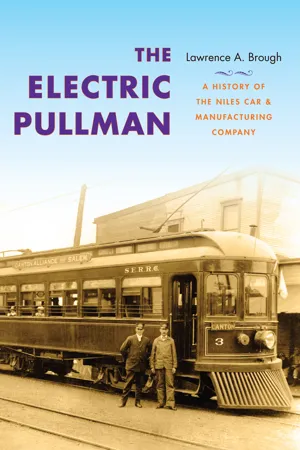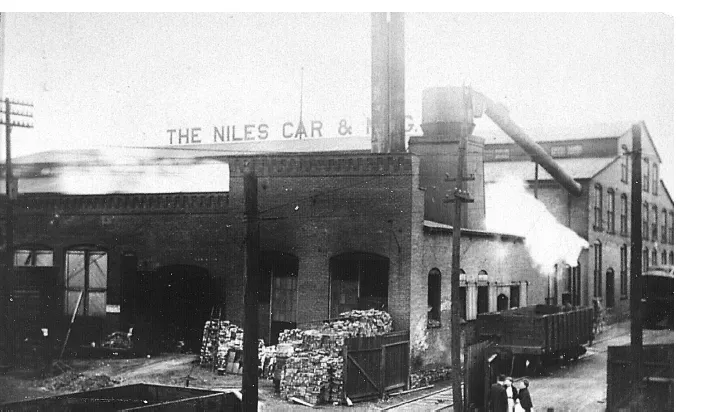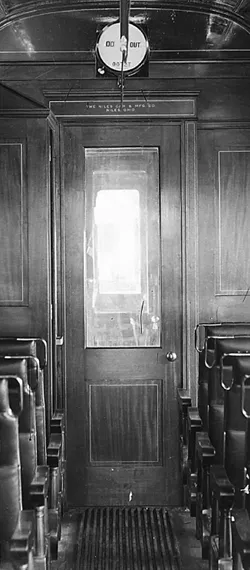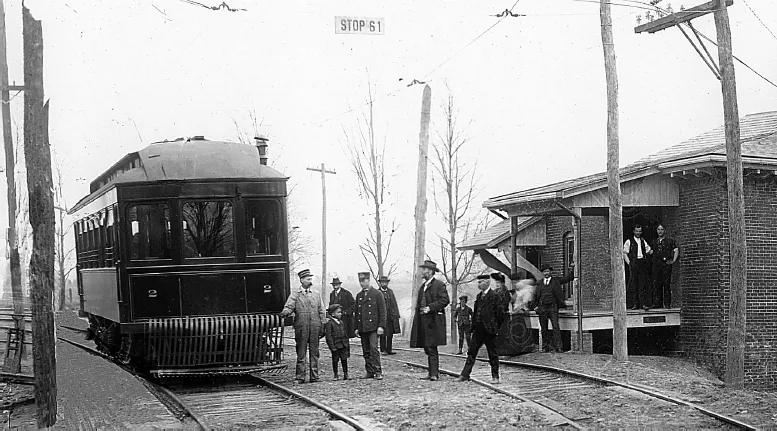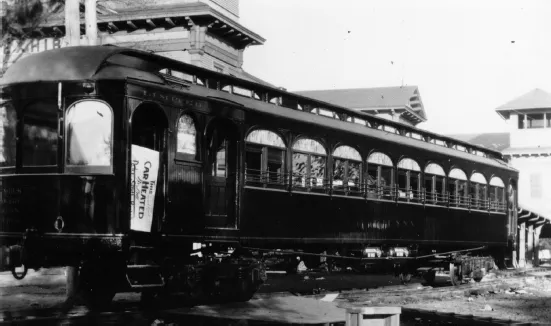![]()
1
THE CURTAIN RISES
The year was 1901. William McKinley, the favorite son of Niles, Ohio, began his second term in office as president of the United States. National unemployment was at 4 percent, and Marconi demonstrated his wireless by sending messages through the air from England to Newfoundland. The electric railway era was well along and, like the steam railroads before, electric lines were springing up all over the country in an attempt to connect nearly every town and hamlet. Did this look like an opportunity to invest in America’s future? It did to a group of Niles businessmen, and on May 3, 1901, they incorporated the Niles Car & Manufacturing Company, which, according to its Articles of Incorporation, intended to “manufacture and deal in all kinds of street and railway cars, motors, steam engines, water tanks, and acid tanks and for manufacturing and dealing in railway supplies and appliances of all kinds.” The company was capitalized at $200,000.
The inclusion of the manufacture of water and acid tanks was no doubt influenced by the fact that Niles was located in what was then the heart of industrial America and was home to steel mills, rolling mills, and plants that produced glass, pottery, and firebrick—businesses that would require such equipment—and these tanks were made out of wood, as would be the trolley car bodies. Among the investors were F. J. Roller, superintendent of schools; B. F. Pew, a prominent Niles grocer; G. B. Robbins, director of the Dollar Savings Bank (whose brother, Frank Robbins, became President of Niles); and W. C. Allison, president of the Allison and Company planing mill, whose property would soon become the site of the Niles car factory.
By June 1901, the planing mill had been removed and construction of the Niles factory was well under way. It occupied four and a half acres and was to be a substantial facility consisting of two erecting shops each about 130 × 200 feet, and each capable of holding over forty cars; a paint shop for twenty-five cars; and a two-story mill of 130 × 200 feet, with the second floor holding cabinet, upholstering, varnish, and headlining operations connected by an electric elevator. The buildings also included a dry kiln, a blacksmith shop, a machine shop, and a two-story office with drafting on the second floor. The facilities were equipped with the latest electrically operated machinery and a transfer table capable of holding an 80-foot car to move cars between buildings.
The buildings were so arranged that lumber entered the mill directly from the dry kiln and then passed directly to the erecting shop. From there, the car, in the rough, passed into the paint shop. Great care was taken in arranging the shops so material would be handled only once in each department. It was estimated that the completed works would cost seventy-five thousand dollars and would employ about three hundred men. The new endeavor so excited city officials that they immediately authorized the construction of fifty new homes to house the employees.
The incorporators wisely hired men with car-building experience to commence operations. A. W. Scholl, assistant superintendent, had eleven years with the Jackson & Sharp car company and eleven with the Pullman Company. Fred McBrien, mill foreman, had four years with the Pullman and American Car companies. A. L. Jacobs, superintendent, and George Pratt, general superintendent of the works and contracting agent, both had a number of years at car-building factories. Their contacts in the industry would be invaluable.
The company made it very clear that it was going to build a substantial product and supply the very best equipment with the latest and newest designs, and that it would depart from the antiquated horse-car type of construction and substitute the most modern construction to withstand severe service. By September, it was announced that orders had been received for twenty-four 18-foot cars complete with motors and trucks (undoubtedly single-truck city cars), and for rebuilds of sixteen other cars. It was anticipated that the factory would be ready for operation by mid-November, but that proved to be optimistic. However, by early the following year, things were humming. In mid-February, the plant was working full time and had orders in hand from six more traction lines, for a total of nearly one hundred cars. So confident was the firm that it immediately began building for stock a number of ten-and twelve-bench open cars for early spring delivery.
The main office of the company was located in the two-story portion of the building, in the northwest corner facing Erie Street, with the machine shop, dry lumber storage, and lumber drying kiln in the adjacent part of the building. The boiler room was in the southwest corner. The westernmost large building was the mill and was used for bench work, gluing, and so on, while the center building was an erection hall. The easternmost building was the paint shop. A transfer table moved the cars sideways between the erection hall and the paint shop.
FIGURE 1.1. The Niles Car & Manufacturing Company factory as it appeared in 1902. Sanborn Fire Map.
FIGURE 1.2. Postcard view of the Erie Street side of the Niles factory. The office was located in the two-story part of the facility on the left. Author’s collection.
FIGURE 1.3. Boiler room and Erie Railroad siding. Niles Historical Society.
The shop was completely sprinkled and the mill equipped with a dust collector that delivered the dust to the boilers, where it was burned and the steam used to dry lumber in the kiln located in the room next to the boiler.
![]()
2
THE CATALOG
The Niles Car & Manufacturing Company entered a business that was already crowded with well-established car builders, many of which had evolved from carriage-, horse-, and cable-car building. There were three other large car builders in Ohio alone, which was not surprising because there were soon to be more miles of electric railways in Ohio than in any other state. Therefore, Niles had to offer something the others did not. The company management decided at the outset to adopt robust steam railroad car construction, and nothing epitomized that better than the products of the Pullman Car Company. By the early twentieth century the name Pullman usually meant a sleeping car owned and staffed by the Pullman Company but operated by the railroad. Pullman also built other types of cars for the steam railroads as well as cars for electric railways. Niles succeeded in building interurbans that were so highly regarded that many traction lines began to refer to them as “Electric Pullmans.” No higher praise could have been bestowed on the cars.
The early Niles products were almost entirely wood in construction, the standard at the time for other car builders as well. Cabinetmaking was an art that flourished at that time and was well-adapted to car building, as the cars were elaborately decorated inside with inlaid woods. The process was similar to building a house: first the framework was built, then the car was finished inside and out. In addition to fancy woods, pinstriping was used extensively inside and out to impress the rider with a sense of luxury.
Cars were identified as having been built by Niles by a sign over the door at one end, usually the front of the car leading to the motorman’s cab. There could be no doubt where the car came from.
In Niles’s own words as published in the Street Railway Journal, the company’s designs “consist of all styles and sizes of electric railway cars, heavy interurban, medium size suburban and city service cars of closed, open and convertible types, but the company’s specialty is large cars for fast interurban service and electric parlor cars for limited extra fare service.” The company offered the following types of cars:
FIGURE 2.1. Door to the motorman’s compartment with sign overhead identifying the car builder.
FIGURE 2.2. Sign over the motorman’s compartment door, detail. Author’s collection.
INTERURBAN PASSENGER CARS
“This company follows the standard method of steam railroad coach construction wherever practical in its interurban cars, it having been proven in actual service that the lighter cars which are the outgrowth of street cars are not sufficiently strong or steady riding for high speed service on interurban lines.” The company believed “that interurban passengers should receive equal comforts and smooth noiseless transportation as on steam railways.” It was Niles’s building to “steam railroad standards” that was to set it apart from the other car builders.
FIGURE 2.3. Stark Electric Railway No. 2, one of six coaches made in 1902 for this line during Niles’s first year of operation. Reproduced with permission from the Rodman Public Library and Alliance Memory, Alliance, Ohio.
FIGURE 2.4. Postcard view of the Columbus Delaware & Marion Railway parlor car “Glenna,” exhibited at the Central Electric Railroad Association convention in Columbus, Ohio, in 1906. This and a sister car, “Mary,” were not long in Ohio but went the following year to the Illinois Traction Company, where they ran for many years. The sign in the rear doorway says, “This car heated by the Peter Smith Heater,” a hot water system popular at that time. Author’s collection.
LIMITED SERVICE EXTRA FARE PARLOR CARS
“It is becoming recognized among interurban railway managers that a certain portion of their patrons are not only willing but anxious to pay extra for extra service and that an individual parlor car chair in a richly finished and carpeted car with lavatory, observation windows, etc. is an inducement to electric railway traffic as well as a paying investment and advertisement for the road.” Maybe the patron could not afford the parlor seat but was comforted by knowing it was available.
OPEN CARS
Niles open cars “are usually built with 10, 12, 13, 14, 15 or 16 transverse benches or seats full width of car with a folding step or running board full length of car on each side and with sliding guards on post grab handles so either or both sides of car can be closed as desired. A transverse bulkhead with drop sash at each end of car separates two end seats which have stationary backs, all other seats have reversible backs. The ten bench car is the ...
